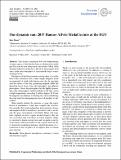Our dynamic sun : 2017 Hannes Alfvén Medal lecture at the EGU
Abstract
This lecture summarises how our understanding of many aspects of the Sun has been revolutionised over the past few years by new observations and models. Much of the dynamic behaviour of the Sun is driven by the magnetic field since, in the outer atmosphere, it represents the largest source of energy by far. The interior of the Sun possesses a strong shear layer at the base of the convection zone, where sunspot magnetic fields are generated. A small-scale dynamo may also be operating near the surface of the Sun, generating magnetic fields that thread the lowest layer of the solar atmosphere, the turbulent photosphere. Above the photosphere lies the highly dynamic fine-scale chromosphere, and beyond that is the rare corona at high temperatures exceeding 1 million degrees K. Possible magnetic mechanisms for heating the corona and driving the solar wind (two intriguing and unsolved puzzles) are described. Other puzzles include the structure of giant flux ropes, known as prominences, which have complex fine structure. Occasionally, they erupt and produce huge ejections of mass and magnetic fields (coronal mass ejections), which can disrupt the space environment of the Earth. When such eruptions originate in active regions around sunspots, they are also associated with solar flares, in which magnetic energy is converted to kinetic energy, heat and fast-particle energy. A new theory will be presented for the origin of the twist that is observed in erupting prominences and for the nature of reconnection in the rise phase of an eruptive flare or coronal mass ejection.
Citation
Priest , E 2017 , ' Our dynamic sun : 2017 Hannes Alfvén Medal lecture at the EGU ' , Annales Geophysicae , vol. 35 , pp. 805-816 . https://doi.org/10.5194/angeo-35-805-2017
Publication
Annales Geophysicae
Status
Peer reviewed
ISSN
0992-7689Type
Journal item
Collections
Items in the St Andrews Research Repository are protected by copyright, with all rights reserved, unless otherwise indicated.

